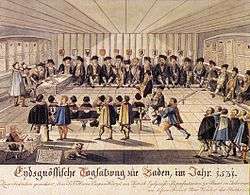Tagsatzung


The Federal Diet of Switzerland or Tagsatzung (German: Eidgenössische Tagsatzung; French: Diète fédérale; Italian: Dieta federale) was the legislative and executive council of the Swiss confederacy from its beginnings until the formation of the Swiss federal state in 1848.
It was a meeting of delegates of the individual cantons. Its power was very limited, since the cantons were essentially sovereign. It was the most important institution of the Old Swiss Confederacy.[1]
It repa lasted longer than any other representative organ in world history.[1]
The composition and functions of the Tagsatzung evolved since the 13th century.[2] It was notably re-organized by the Federal Treaty (Bundesvertrag) of 7 August 1815.
Organisation
The presiding canton was known as the Vorort, usually the canton which had called the Tagsatzung. The Tagsatzung was held in various locations, Baden being popular because of its hot springs.
The last three presiding cantons were Bern, Lucerne and Zürich. Bern was chosen as the 'federal city' (Bundesstadt, with deliberate avoidance of the term 'capital' or Hauptstadt) in 1848.[3]
See also
References
- 1 2 (French) Urs Hafner, "Une assemblée méconnue", Horizons magazine, number 104, edited by the Swiss National Science Foundation and the Swiss Academies of Arts and Sciences, 2015.
- ↑ Tagsatzung in German, French and Italian in the online Historical Dictionary of Switzerland.
- ↑ Bundesstadt in German, French and Italian in the online Historical Dictionary of Switzerland.
External links
| Wikimedia Commons has media related to Tagsatzung. |
- Tagsatzung in German, French and Italian in the online Historical Dictionary of Switzerland.
- Vorort in German, French and Italian in the online Historical Dictionary of Switzerland.